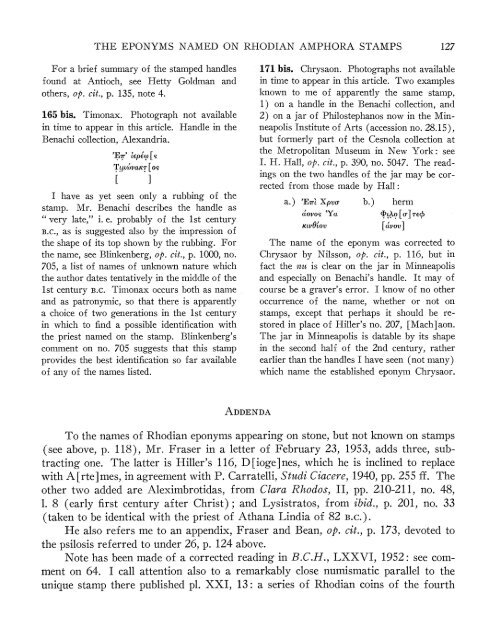the eponyms named on rhodian amphora stamps - The American ...
the eponyms named on rhodian amphora stamps - The American ...
the eponyms named on rhodian amphora stamps - The American ...
Create successful ePaper yourself
Turn your PDF publications into a flip-book with our unique Google optimized e-Paper software.
THE EPONYMS NAMED ON RHODIAN AMPHORA STAMPS 127<br />
For a brief summary of <str<strong>on</strong>g>the</str<strong>on</strong>g> stamped handles<br />
found at Antioch, see Hetty Goldman and<br />
o<str<strong>on</strong>g>the</str<strong>on</strong>g>rs, op. cit., p. 135, note 4.<br />
165 bis. Tim<strong>on</strong>ax. Photograph not available<br />
in time to appear in this article. Handle in <str<strong>on</strong>g>the</str<strong>on</strong>g><br />
Benachi collecti<strong>on</strong>, Alexandria.<br />
'E7r' iEpep[c<br />
TL/uJvaKT [os<br />
[I ]<br />
I have as yet seen <strong>on</strong>ly a rubbing of <str<strong>on</strong>g>the</str<strong>on</strong>g><br />
stamp. Mr. Benachi describes <str<strong>on</strong>g>the</str<strong>on</strong>g> handle as<br />
" very late," i. e. probably of <str<strong>on</strong>g>the</str<strong>on</strong>g> 1st century<br />
B.C., as is suggested also by <str<strong>on</strong>g>the</str<strong>on</strong>g> impressi<strong>on</strong> of<br />
<str<strong>on</strong>g>the</str<strong>on</strong>g> shape of its top shown by <str<strong>on</strong>g>the</str<strong>on</strong>g> rubbing. For<br />
<str<strong>on</strong>g>the</str<strong>on</strong>g> name, see Blinkenberg, op. cit., p. 1000, no.<br />
705, a list of names of unknown nature which<br />
<str<strong>on</strong>g>the</str<strong>on</strong>g> author dates tentatively in <str<strong>on</strong>g>the</str<strong>on</strong>g> middle of <str<strong>on</strong>g>the</str<strong>on</strong>g><br />
1st century B.C. Tim<strong>on</strong>ax occurs both as name<br />
and as patr<strong>on</strong>ymic, so that <str<strong>on</strong>g>the</str<strong>on</strong>g>re is apparently<br />
a choice of two generati<strong>on</strong>s in <str<strong>on</strong>g>the</str<strong>on</strong>g> 1st century<br />
in which to find a possible identificati<strong>on</strong> with<br />
<str<strong>on</strong>g>the</str<strong>on</strong>g> priest <str<strong>on</strong>g>named</str<strong>on</strong>g> <strong>on</strong> <str<strong>on</strong>g>the</str<strong>on</strong>g> stamp. Blinkenberg's<br />
comment <strong>on</strong> no. 705 suggests that this stamp<br />
provides <str<strong>on</strong>g>the</str<strong>on</strong>g> best identificati<strong>on</strong> so far available<br />
of any of <str<strong>on</strong>g>the</str<strong>on</strong>g> names listed.<br />
ADDENDA<br />
171 bis. Chrysa<strong>on</strong>. Photographs not available<br />
in time to appear in this article. Two examples<br />
known to me of apparently <str<strong>on</strong>g>the</str<strong>on</strong>g> same stamp,<br />
1) <strong>on</strong> a handle in <str<strong>on</strong>g>the</str<strong>on</strong>g> Benachi collecti<strong>on</strong>, and<br />
2) <strong>on</strong> a jar of Philostephanos now in <str<strong>on</strong>g>the</str<strong>on</strong>g> Min-<br />
neapolis Institute of Arts (accessi<strong>on</strong> no. 28.15),<br />
but formerly part of <str<strong>on</strong>g>the</str<strong>on</strong>g> Cesnola collecti<strong>on</strong> at<br />
<str<strong>on</strong>g>the</str<strong>on</strong>g> Metropolitan Museum in New York: see<br />
I. H. Hall, op. cit., p. 390, no. 5047. <strong>The</strong> read-<br />
ings <strong>on</strong> <str<strong>on</strong>g>the</str<strong>on</strong>g> two handles of <str<strong>on</strong>g>the</str<strong>on</strong>g> jar may be cor-<br />
rected from those made by Hall:<br />
a.) 'Ewrt Xpvxr b.) herm<br />
aovos 'Ya CItAo [f] TrE<br />
KlVOlOV [avov]<br />
<strong>The</strong> name of <str<strong>on</strong>g>the</str<strong>on</strong>g> ep<strong>on</strong>ym was corrected to<br />
Chrysaor by Nilss<strong>on</strong>, op. cit., p. 116, but in<br />
fact <str<strong>on</strong>g>the</str<strong>on</strong>g> nu is clear <strong>on</strong> <str<strong>on</strong>g>the</str<strong>on</strong>g> jar in Minneapolis<br />
and especially <strong>on</strong> Benachi's handle. It may of<br />
course be a graver's error. I know of no o<str<strong>on</strong>g>the</str<strong>on</strong>g>r<br />
occurrence of <str<strong>on</strong>g>the</str<strong>on</strong>g> name, whe<str<strong>on</strong>g>the</str<strong>on</strong>g>r or not <strong>on</strong><br />
<strong>stamps</strong>, except that perhaps it should be re-<br />
stored in place of Hiller's no. 207, [Mach]a<strong>on</strong>.<br />
<strong>The</strong> jar in Minneapolis is datable by its shape<br />
in <str<strong>on</strong>g>the</str<strong>on</strong>g> sec<strong>on</strong>d half of <str<strong>on</strong>g>the</str<strong>on</strong>g> 2nd century, ra<str<strong>on</strong>g>the</str<strong>on</strong>g>r<br />
earlier than <str<strong>on</strong>g>the</str<strong>on</strong>g> handles I have seen (not many)<br />
which name <str<strong>on</strong>g>the</str<strong>on</strong>g> established ep<strong>on</strong>ym Chrysaor.<br />
To <str<strong>on</strong>g>the</str<strong>on</strong>g> names of Rhodian <str<strong>on</strong>g>ep<strong>on</strong>yms</str<strong>on</strong>g> appearing <strong>on</strong> st<strong>on</strong>e, but not known <strong>on</strong> <strong>stamps</strong><br />
(see above, p. 118), Mr. Fraser in a letter of February 23, 1953, adds three, sub-<br />
tracting <strong>on</strong>e. <strong>The</strong> latter is Hiller's 116, D[ioge]nes, which he is inclined to replace<br />
with A[rte] mes, in agreement with P. Carratelli, Studi Ciacere, 1940, pp. 255 ff. <strong>The</strong><br />
o<str<strong>on</strong>g>the</str<strong>on</strong>g>r two added are Aleximbrotidas, from Clara Rhodos, II, pp. 2110-211, no. 48,<br />
1. 8 (early first century after Christ); and Lysistratos, from ibid., p. 201, no. 33<br />
(taken to be identical with <str<strong>on</strong>g>the</str<strong>on</strong>g> priest of Athana Lindia of 82 B.C.).<br />
He also refers me to an appendix, Fraser and Bean, op. cit., p. 173, devoted to<br />
<str<strong>on</strong>g>the</str<strong>on</strong>g> psilosis referred to under 26, p. 124 above.<br />
Note has been made of a corrected reading in B.C.H., LXXVI, 1952: see com-<br />
ment <strong>on</strong> 64. I call attenti<strong>on</strong> also to a remarkably close numismatic parallel to <str<strong>on</strong>g>the</str<strong>on</strong>g><br />
unique stamp <str<strong>on</strong>g>the</str<strong>on</strong>g>re published pl. XXI, 13: a series of Rhodian coins of <str<strong>on</strong>g>the</str<strong>on</strong>g> fourth

















